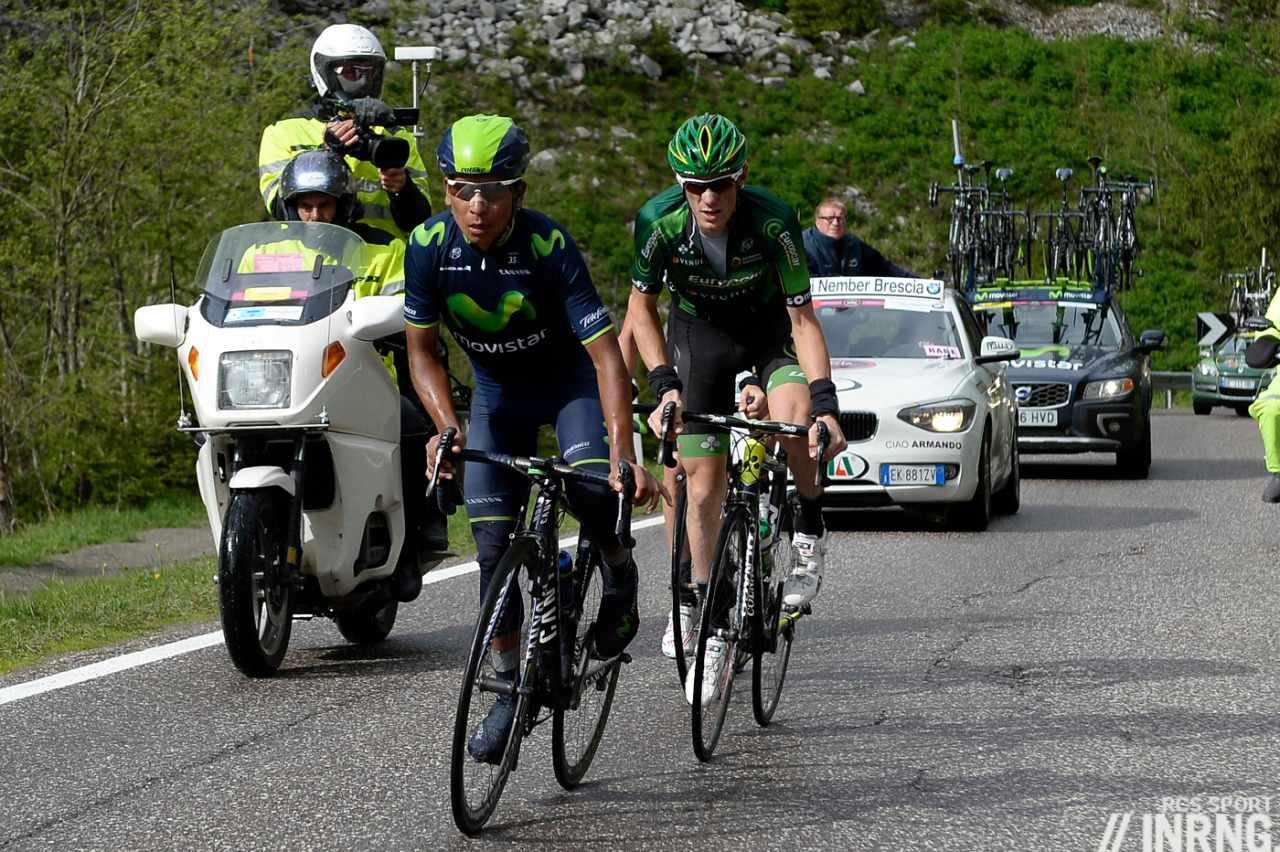 Nairo Quintana leads on the stage to Val Martello. He’d gone clear on the descent of the Passo dello Stelvio launching a post-race controversy – one of many to mark the race – but it was on the climb to the finish that he built his lead.
Nairo Quintana leads on the stage to Val Martello. He’d gone clear on the descent of the Passo dello Stelvio launching a post-race controversy – one of many to mark the race – but it was on the climb to the finish that he built his lead.
This was a race with plenty of action with no team was able to control the race either in the plains or the high mountains. Here’s a look back at events and some thoughts on the race.
Was the weather the biggest tactical factor? It was certainly consistent, typing each stage preview seemed to involve copy-pasting the previous day’s forecast: cool , cloudy and the chance of rain every afternoon. It poured in Ireland as expected but in logistical effort to transport the race back to Italy it was as if someone packed the clouds too.
 The opening weekend in Belfast and Dublin shouldn’t be remembered for the rain. The giant crowds were so impressive. Garmin-Sharp’s collective crash gave an early moment of the drama and chaos that we’d get for the next three weeks.
The opening weekend in Belfast and Dublin shouldn’t be remembered for the rain. The giant crowds were so impressive. Garmin-Sharp’s collective crash gave an early moment of the drama and chaos that we’d get for the next three weeks.
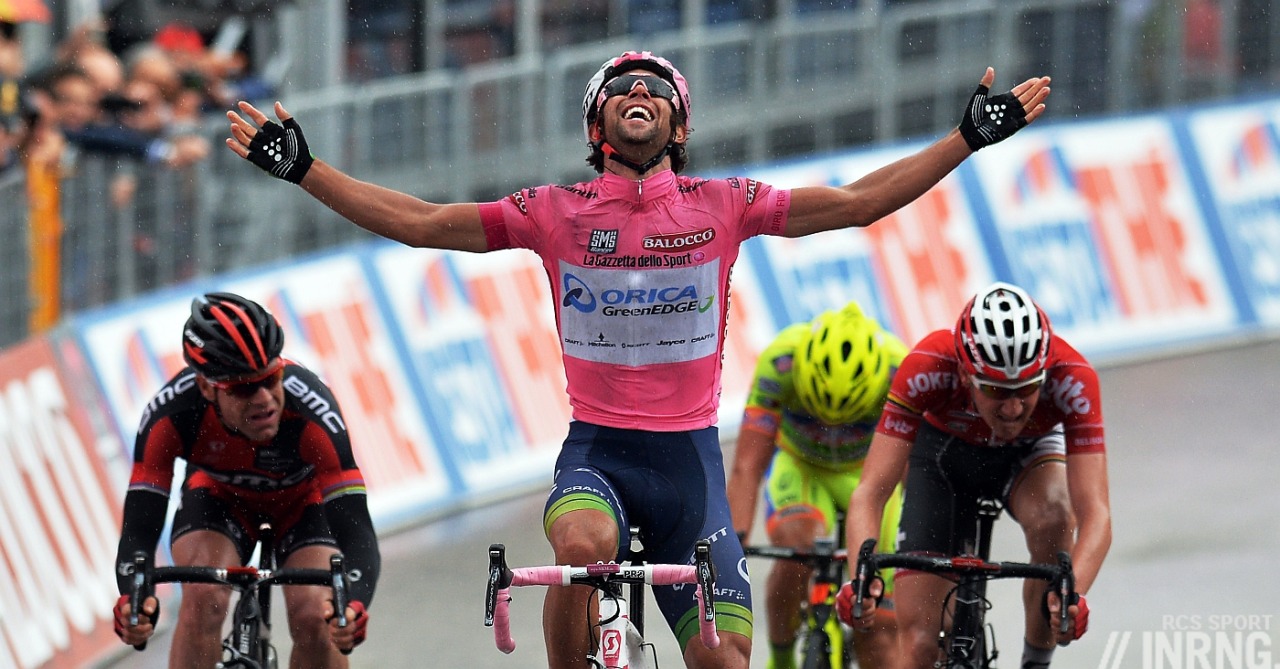 Michael Matthews had a great first week. A prodigious talent, it’s said he got lazy after signing a good contract, that the hunger had gone. But he went back to work and the results were obvious before the Giro with a stage win in the Tour of the Basque Country before several days in the maglia rosa. Now he’ll ride the Tour de France, a challenger to Peter Sagan for the green jersey.
Michael Matthews had a great first week. A prodigious talent, it’s said he got lazy after signing a good contract, that the hunger had gone. But he went back to work and the results were obvious before the Giro with a stage win in the Tour of the Basque Country before several days in the maglia rosa. Now he’ll ride the Tour de France, a challenger to Peter Sagan for the green jersey.
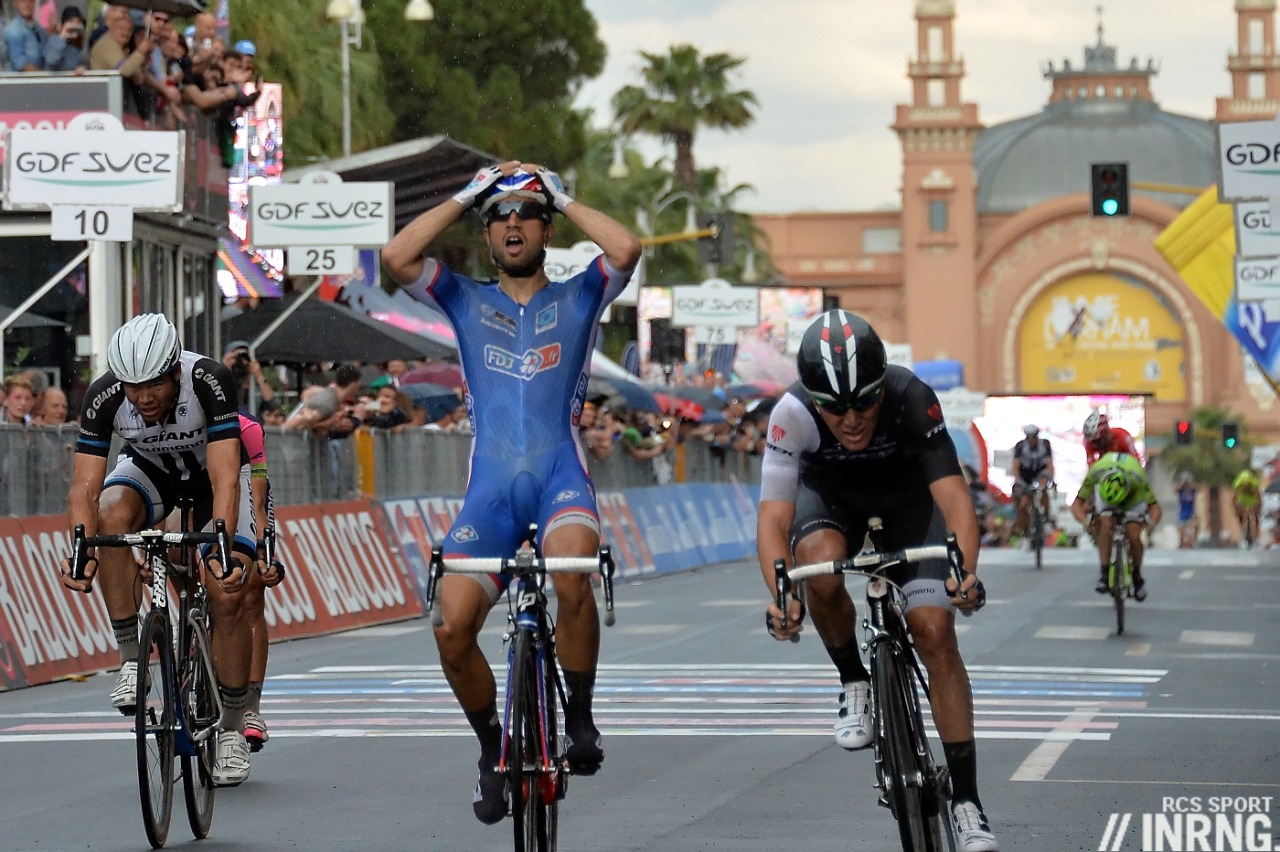 Another early success was Nacer Bouhanni, the sprint king. It could have been different had Marcel Kittel not vanished. Certainly the German’s sprint win in Dublin was among the best we’ve ever seen, he surged from nowhere in what the Italians call a fucilata or gunshot to leave his rivals stunned and collapsed after the line where a fan – a member of Nicolas Roche’s development squad – posed for a selfie with the broken rider to generate another Twitter storm. But Bouhanni was no consolation poaching wins, instead he was clearly the fastest and boldest rider left in the race. All this occurred as L’Equipe reported daily twists on his employment future with FDJ just as Arnaud Démare was sporting a maillot rose, this time as leader of the Four Days of Dunkirk.
Another early success was Nacer Bouhanni, the sprint king. It could have been different had Marcel Kittel not vanished. Certainly the German’s sprint win in Dublin was among the best we’ve ever seen, he surged from nowhere in what the Italians call a fucilata or gunshot to leave his rivals stunned and collapsed after the line where a fan – a member of Nicolas Roche’s development squad – posed for a selfie with the broken rider to generate another Twitter storm. But Bouhanni was no consolation poaching wins, instead he was clearly the fastest and boldest rider left in the race. All this occurred as L’Equipe reported daily twists on his employment future with FDJ just as Arnaud Démare was sporting a maillot rose, this time as leader of the Four Days of Dunkirk.
We got more rain and a fresh polemic with the Montecassino maxicaduta where many riders crashed with less than 10km to go. Only a small group of riders were left upright at the front of the bunch. Matthews won the day and Cadel Evans took time on his GC rivals but the stage continued for hours as riders lay in hospital and fans debated the outcome on social media and forums. These debates raged in the bunch and team cars too with different views on what caused the crash and what should have been done. Cadel Evans mid-race reign came to an end in the Barolo time trial thanks to Rigoberto Urán’s surprise win. The Australian had a great race but now finds the media talking about retirement, legacy and more.
It might be hindsight but the mountain stages looked cleverly designed, each progressively harder and more decisive. The two stages in the Apenines were selective but not conclusive, aggression by Domenico Pozzovivo, Julián Arredondo and Pierre Rolland would be a theme for the rest of the race with the Frenchman given room to attack because he was so far down on GC but turning these moves into time-grabbing escapades to finish fourth overall.
Montecampione was the first true summit finish and we had a surprise with the triumph of Fabio Aru. He enjoyed front page billing on La Gazzetta Dello Sport, eclipsing Diego Ulissi’s twin stage wins.
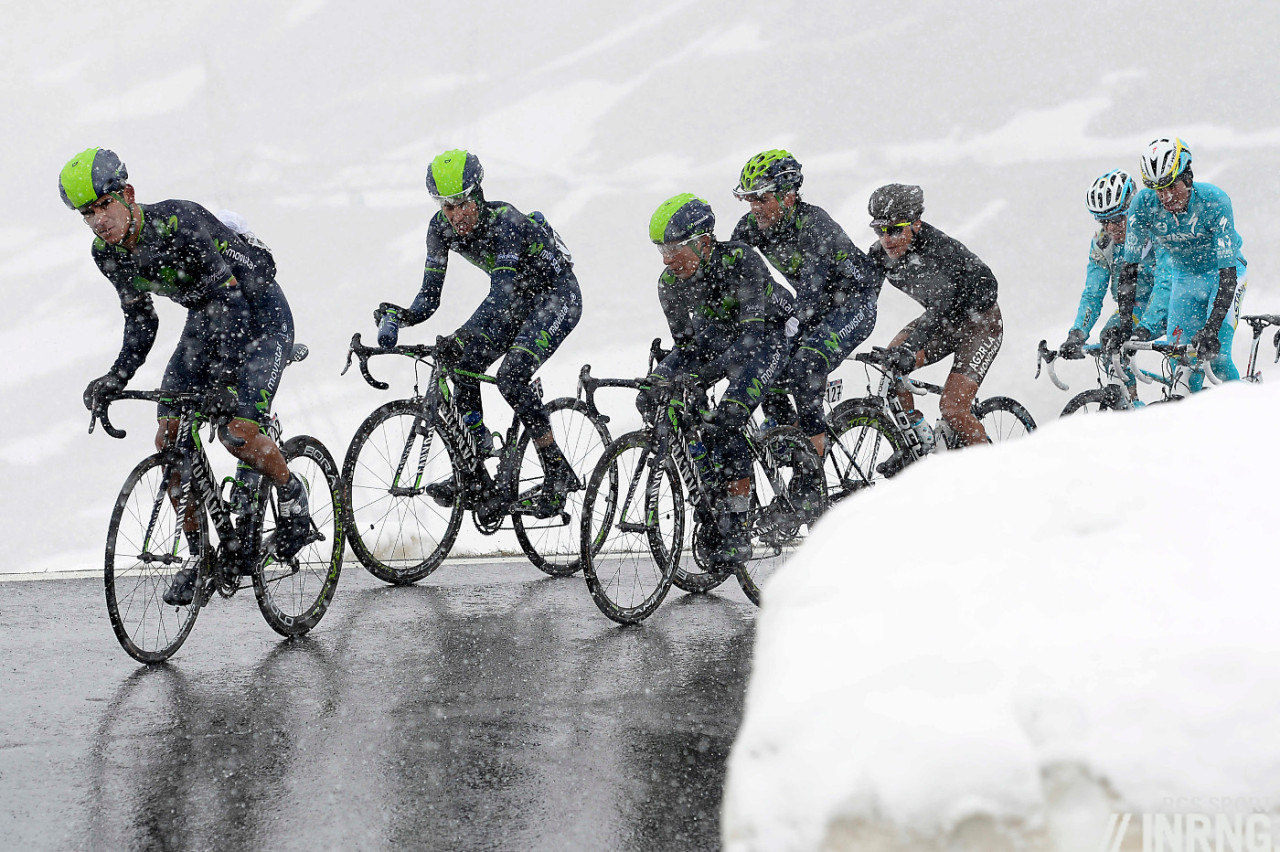 Then came Stage 16. The same stage was cancelled last year and the Giro could not afford a second no show. But the forecast was grim and the ok to race was only given hours before the start. Snow by itself isn’t a problem, it’s the damp and the windchill which makes it so hard. Going up the Gavia pass Quintana was so cold he thought of abandoning, unable to eat because of frozen hands it was left to Ion Izaguirre to ram a sandwich into the Colombian’s mouth. Onto the Stelvio and Dario Cataldo lead to win the Cima Coppi prize but there was talk of neutralisation on the descent. Only it was vague and when safety required certitude, we got a game of telephone. The word “neutralisation” was used in the Italian broadcast on race radio and if instructions were given out not to overtake on the descent, apparently it was only for the initial hairpin bends near the top.
Then came Stage 16. The same stage was cancelled last year and the Giro could not afford a second no show. But the forecast was grim and the ok to race was only given hours before the start. Snow by itself isn’t a problem, it’s the damp and the windchill which makes it so hard. Going up the Gavia pass Quintana was so cold he thought of abandoning, unable to eat because of frozen hands it was left to Ion Izaguirre to ram a sandwich into the Colombian’s mouth. Onto the Stelvio and Dario Cataldo lead to win the Cima Coppi prize but there was talk of neutralisation on the descent. Only it was vague and when safety required certitude, we got a game of telephone. The word “neutralisation” was used in the Italian broadcast on race radio and if instructions were given out not to overtake on the descent, apparently it was only for the initial hairpin bends near the top.

What is certain is that Nairo Quintana and Pierre Rolland had got away from the other GC contenders and had a team mate each for company along with Ryder Hesjedal. The team mates helped to drive the pace and by the foot of final climb Quintana’s group had two minutes on the chasers with Urán included.
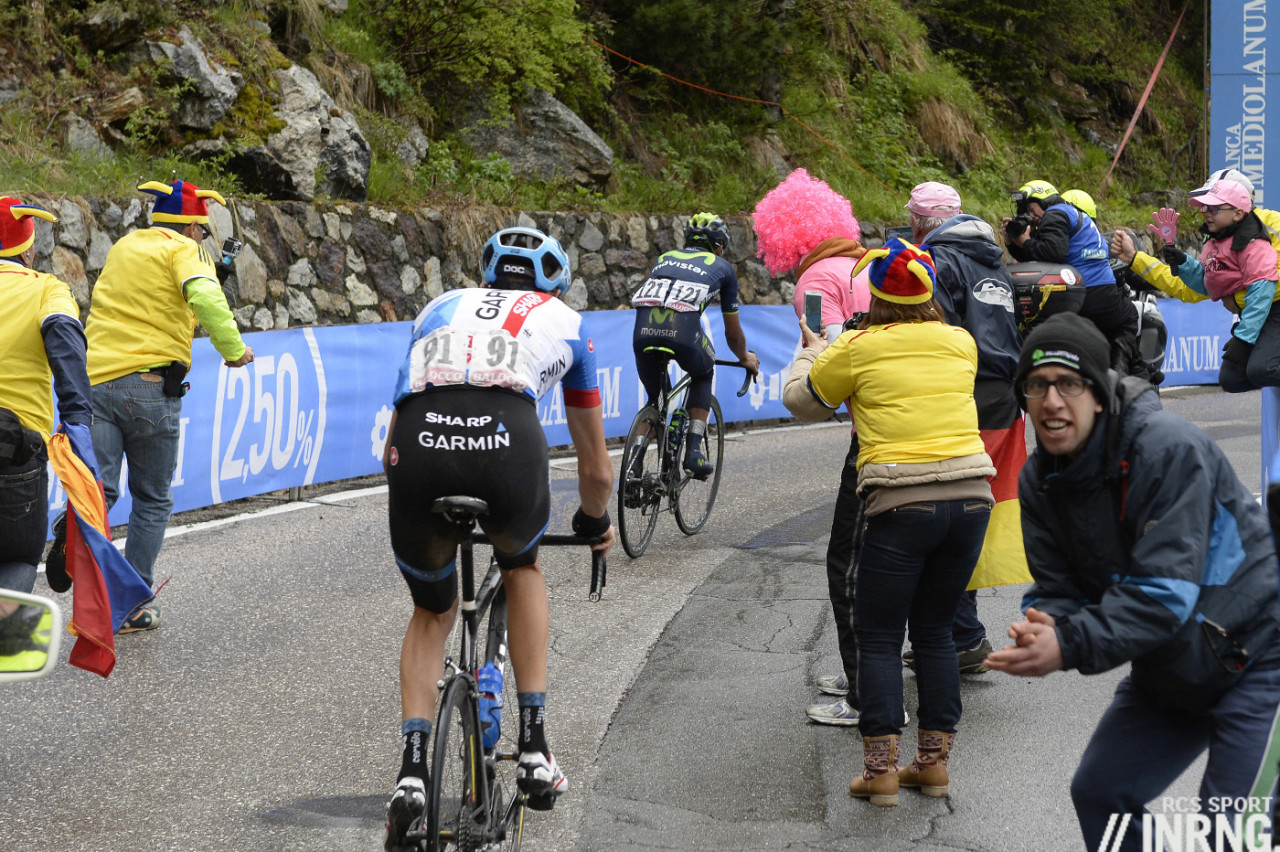 Rolland blew – he confessed to not eating during the stage – and then Hesjedal cracked. Quintana might have hoped to ride to glory and even history but he found himself in a storm over the how and why of his escape down the Stelvio.
Rolland blew – he confessed to not eating during the stage – and then Hesjedal cracked. Quintana might have hoped to ride to glory and even history but he found himself in a storm over the how and why of his escape down the Stelvio.
Will the Stelvio incident be remembered? Quintana seemed visibly affected by the controversy in the press-conference that followed as he accounted for his actions but his stage win on Monte Grappa helped to show he probably was the best climber.
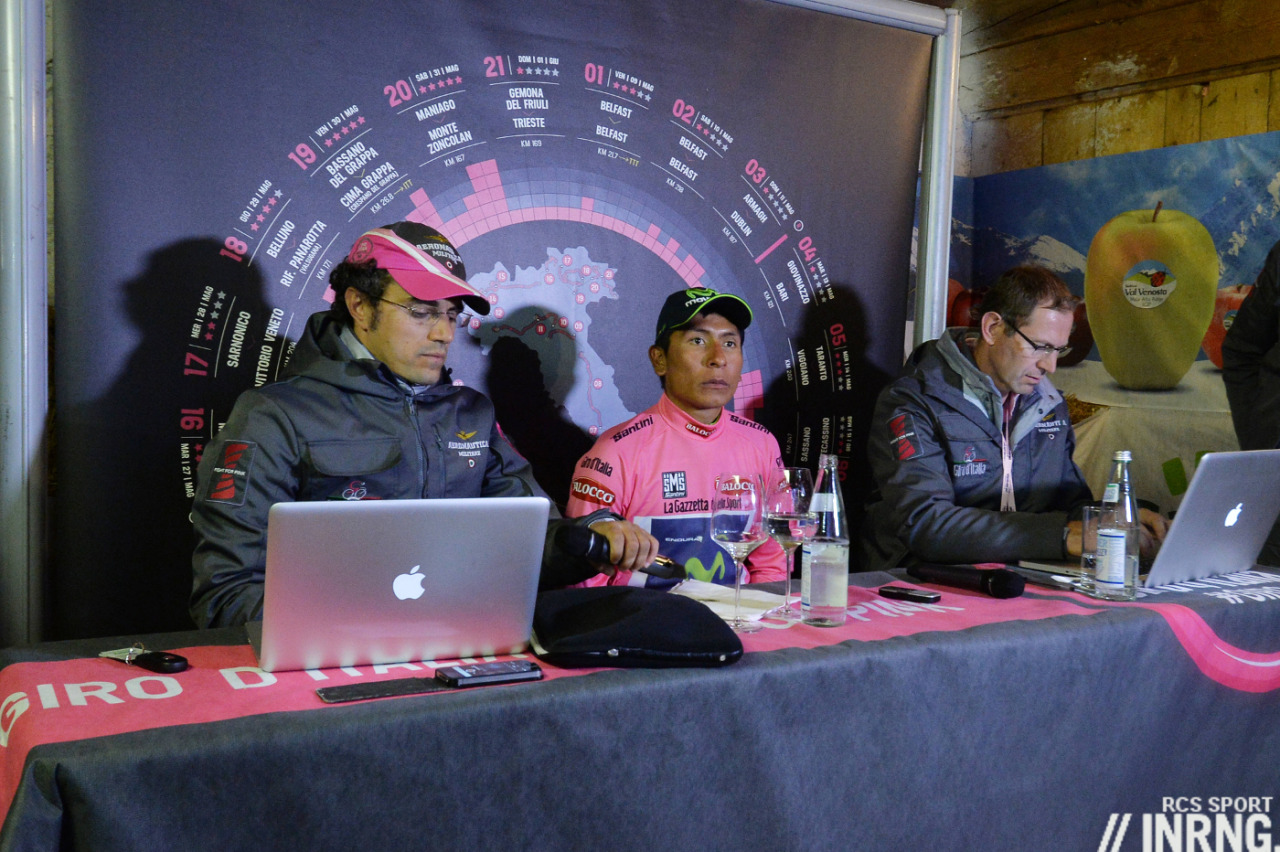 Team owners and managers were understandably upset at Stelvio controversy. But their cries for greater professionalism were ironic given an amateur response. An open air public meeting of managers resembled inmates gathering in a jail yard rather than a business conference and it took over 24 hours to put a statement out by which time the story had gone as cold as the Stelvio’s banks of snow.
Team owners and managers were understandably upset at Stelvio controversy. But their cries for greater professionalism were ironic given an amateur response. An open air public meeting of managers resembled inmates gathering in a jail yard rather than a business conference and it took over 24 hours to put a statement out by which time the story had gone as cold as the Stelvio’s banks of snow.
Stelvio Re-Modelling
For the sake of arithmetic, let’s imagine Nairo Quintana had not gone clear on the Stelvio and finished next to Wilco Kelderman on the climb to Val Martello. You might think he’d have gone faster up the final climb but since we’re already speculating, let’s not complicate things. It would mean Quintana gaining 39 seconds on Urán – just like Kelderman – and so ending the day 2.01 down on Urán. On Stage 18 above Valsugana Quintana and Uran both finished on the same time. Come the Monte Grappa mountain time trial and Quintana put 1.26 into Urán meaning the OPQS would still be leading the GC by 35 seconds.
All these calculations are arithmetic rather than what would have happened. But note had the team managers had their way with the call for the times to be rejigged by cutting the time taken by Quintana on the Stelvio descent but allowing him to keep the advantage gained on the final climb to Valmartello then this means adding roughly 90 seconds: putting Quintana in pink by a minute.
Enough speculation, back to some actual numbers from the race:
The chart above shows the podium finishers standing on GC throughout the race, as measured on the y-axis by the number of seconds behind the maglia rosa. As you can see Quintana reached a trough of 209 seconds (3m29s) after the Stage 12 time trial and climbed his way out. If Stage 16 to Val Martello was crucial, see how Urán and Aru continued to fall away after.
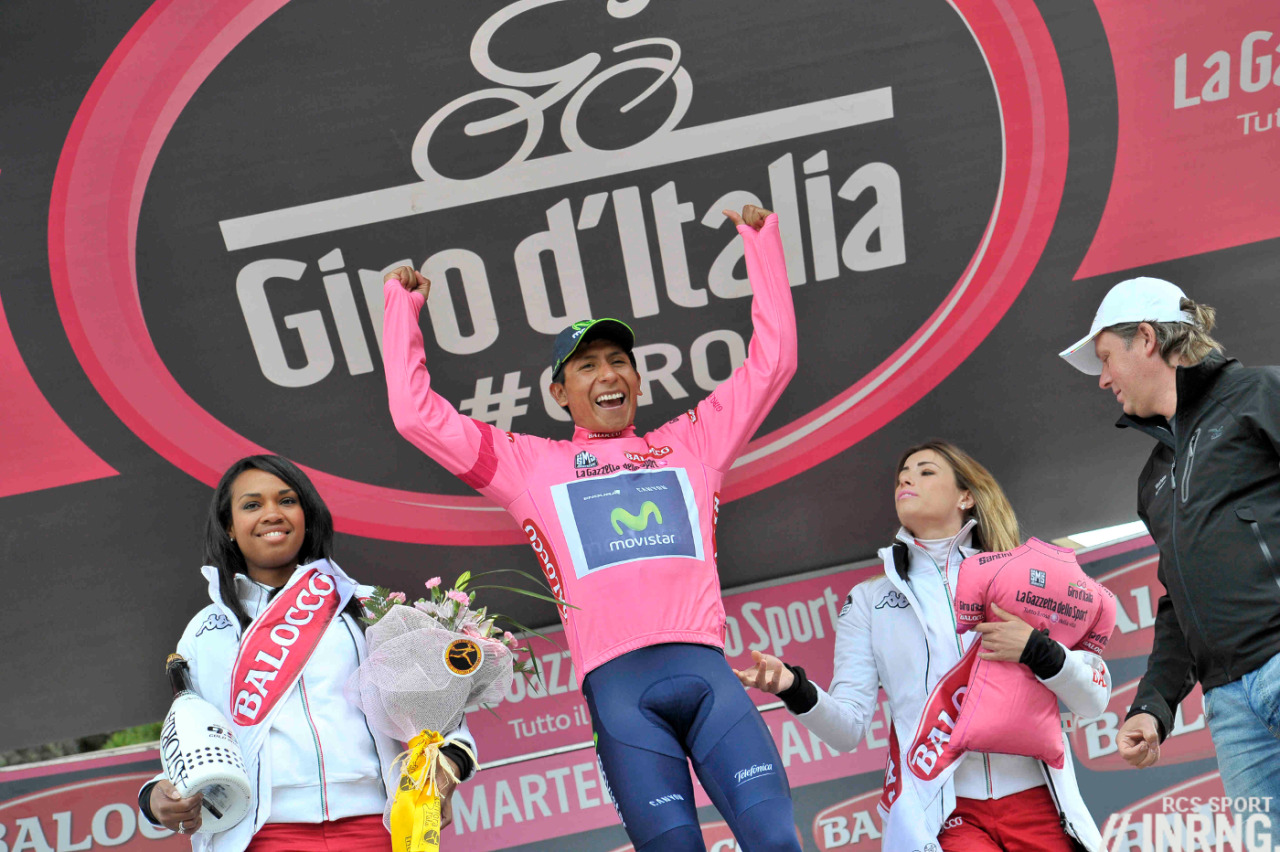
El Condor
Quintana is an elusive personality and hard to get the measure of on the bike. He wears a mask of concentration and without many visible pedalling traits. There’s a slightly slower cadence to the others giving an impression of force. If we can’t tell what’s going on inside it’s what happening to the others that makes him irresistible to watch. Go back to the 2012 Dauphiné and the Col de Joux Plane where was the only rider who could attack Team Sky’s mountain train. Race organisers will be designing routes to suit.
We should also salute the team effort. Movistar are one of only two teams (Trek) to finish with nine men and they started with the sole objective of winning the race. They were visible at all times and it was only when the lead group was reduced to i big that Quintana was without a team mate but so were the others.
Missing in Action
Other teams had a tough time, notably Orica-Greenedge who shrunk to two riders but the Aussie squad had a great race. By contrast several teams been largely invisible for three weeks. By this I mean they’ve not been on TV, this isn’t to knock the suffering, endurance and sheer hard work only it never paid off with glory or visibility. Katusha, Cannondale and Lotto-Belisol stand out for their absence although Moreno, Belkov, Viviani, Basso and Wellens were sometimes on TV.
 Team Sky were racing à la française: sending riders up the road in the hope a move could stick rather than trying to shape the race. This was always going to be the case once they started without an obvious leader, Enrico Battaglin’s sprint against Dario Cataldo crystallised the story. Lampre-Merida almost fall into this camp because without Ulissi they weren’t visible.
Team Sky were racing à la française: sending riders up the road in the hope a move could stick rather than trying to shape the race. This was always going to be the case once they started without an obvious leader, Enrico Battaglin’s sprint against Dario Cataldo crystallised the story. Lampre-Merida almost fall into this camp because without Ulissi they weren’t visible.
De Boyacá en los campos, el genio de la gloria
As well as teams this was a race marked by a nation. The Colombians were all over the race with Quintana, Urán, Arredondo and more. Even the Colombia team had a good time, no stage wins but in Duarte they came close.
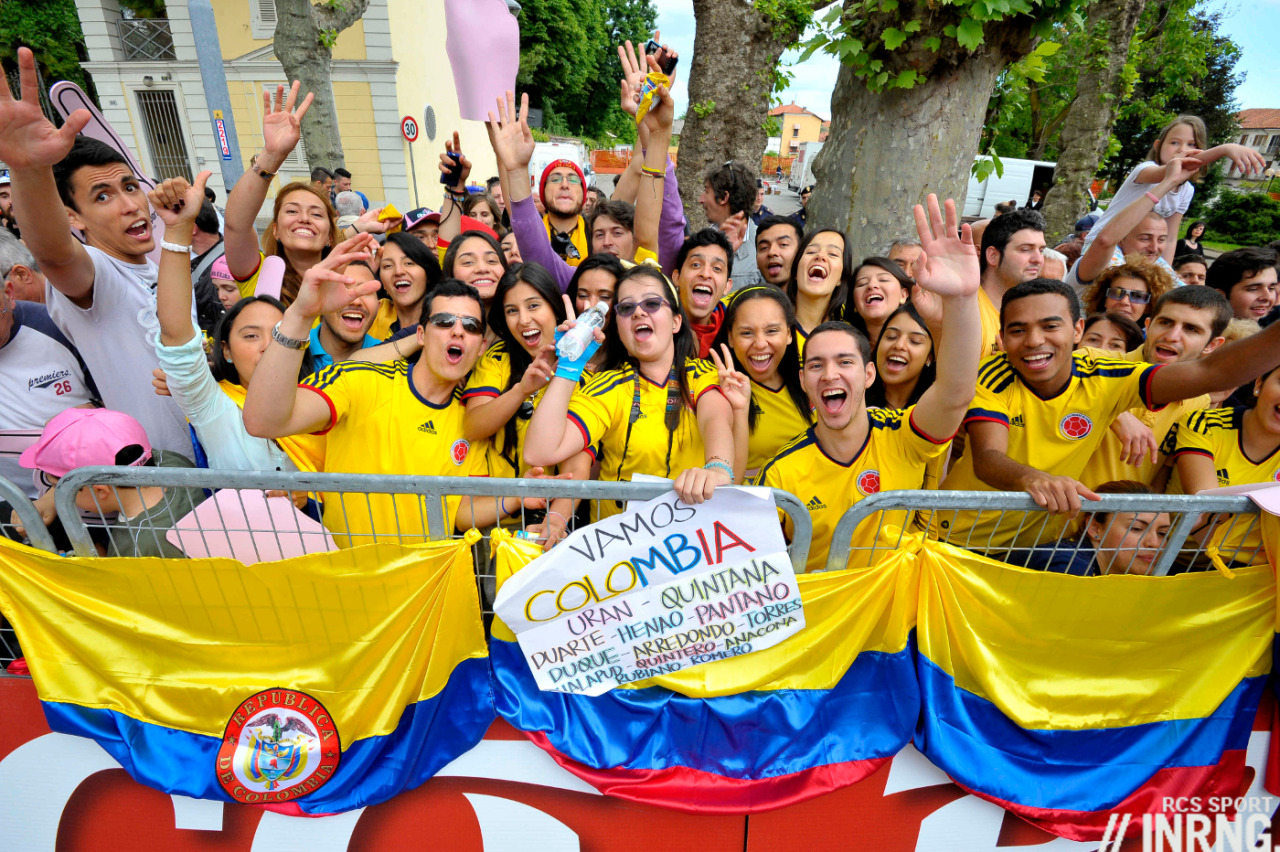
Confirmations and Revelations
Julián Arredondo and Fabio Aru are the two obvious picks with the latter being essential for Italian fans. The humble Sardinian will find enormous pressure and interest. We had Nacer Bouhanni finally winning grand tour stages with confidence. What about Diego Ulissi and his two stage wins? Wilco Keldermann too? In fact all these names are really confirmations rather than revelations as they’ve won races and surprised before. But this was Arredondo’s first grand tour and he’s set to achieve more.
Actual revelations were Ag2r’s Alexis Vuillermoz, 26 today and sitting 11th overall after serving Domenico Pozzovivo. There’s Sky’s Sebastian Henao, a 20 year old neo pro who had two top-10s in the mountains.
The Verdict
Enjoyable with a variety of race leaders and different tactical scenarios. Beyond Ag2r’s efforts in a mountain train we hardly ever saw a team control the race and the result meant attacks, reversals and surprises on the crucial stages. However at times there was too much drama, with crashes, polemics and protests – oddly most of these could have been avoided had the weather been better – culminating in the Stelvio incident. Quintana’s subsequent stage win extinguished doubts about the moral winner. As well as beauty, art and history Italy is a land of exaggeration and crisis and perhaps the polemiche of the race are another reflection of the nation?
Like Zhou Enlai’s misquote on the French revolution it might be too soon to judge the significance of the 2014 Giro as several of the best riders on GC are also under-25, with Fabio Aru, Rafał Majka and Wilco Kelderman all set for success in the years to come. Nairo Quintana won the white jersey too and is the youngest Giro winner for a decade. His next target race is the 2015 Tour de France, an impossible wait. There will be intermediate goals before then but after this race with the Alps, snow, rain as well as the media, surely the only thing that can test Quintana is the Tour de France?
1 Nairo Quintana (Col) Movistar Team 88:14:32
2 Rigoberto Urán (Col) Omega Pharma – Quick-Step Cycling Team 0:02:58
3 Fabio Aru (Ita) Astana Pro Team 0:04:04
4 Pierre Rolland (Fra) Team Europcar 0:05:46
5 Domenico Pozzovivo (Ita) AG2R La Mondiale 0:06:32
6 Rafał Majka (Pol) Tinkoff-Saxo 0:07:04
7 Wilco Kelderman (Ned) Belkin Pro Cycling Team 0:11:00
8 Cadel Evans (Aus) BMC Racing Team 0:11:51
9 Ryder Hesjedal (Can) Garmin Sharp 0:13:35
10 Robert Kišerlovski (Cro) Trek Factory Racing 0:15:49…
…156 Jetse Bol (Ned) Belkin Pro Cycling Team 5:15:19
Red Jersey – Points Competition: Nacer Bouhanni (FDJ.fr)
Blue Jersey – Mountains Competition: Julián Arredondo (Trek Factory Racing)
White Jersey – Best Young Rider: Nairo Quintana (Movistar)
Team Prize: Ag2r La Mondiale
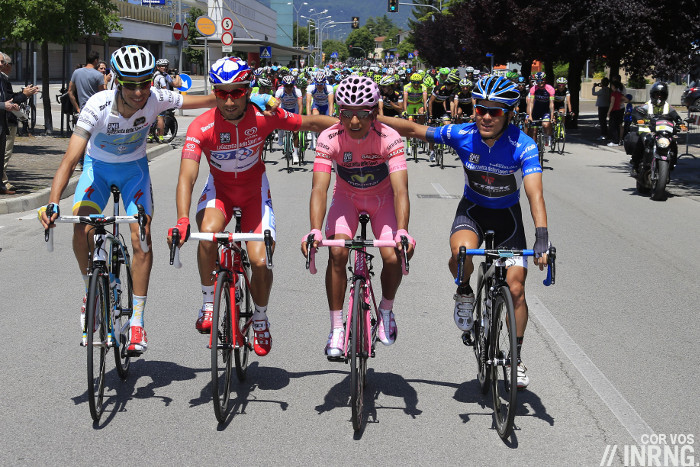

Excellent, balanced summary, as per. Ireland put on a great show, the start was dramatic, and there were some great rides from Kittel, Uran, Aru, and Quintana. I even enjoyed Mezgec’s win in the final crit, with the small hill provided just enough spice. However, I felt too many of the other stages were compromised by crashes and rainbow-jersey wearing bells.
Do we know for sure that the OPQS management have accepted Quintana’s GC win and won’t be going to court to overturn the partially-neutralised stage?
Nice to see Mezgec win with his home country of Slovenia within sight of Trieste, he had a lot of supporters.
We don’t know for sure about OPQS but I can’t see it going any further now.
As usual a brilliant round up covering almost everything of any consequence – how do you find the time ?
The Giro is a special race because it is everything that is Italian, in the broadest sense of the word. Thank you INRNG for three weeks of effort bringing us all the race flavour and behind the scenes insight.
I wonder if this was the last GT for Cadel. I’m the first one to welcome new faces on the podium but at the same time it’s hard to let go of the guys you’ve followed through so many years.
It’s probably be his last GT as the main GC rider….looks like he’ll be supporting Sanchez at the Vuelta. You can’t get the team to back you if you get 8th at the age of 37…..thanks for the memories Cadel!
Not the best Giro of past years… Quintana was a level above the rest and if he was not ill the second week would not have such a deficit to Uran come week 3. I was impressed by AG2R until week 2 but then they seemed to slow down as Pozzovivo sadly lost momentum as was the only one who seemed willing to attack.. Impressed by Aru but not sure how he will cope riding with Nibali in the same team next year…
I think that Giro organizers should seriously consider focusing on crucial stages in south Italy next year, altitudes might be lower but weather much better!
Another hearty thank-you for the time, effort & intelligence you put into the daily briefings and more. I’ve learned to understand and enjoy so much more about road cycling since I became a regular reader of this blog last year, and the past three weeks have been no exception. Molto grazie, INRNG!
Has Quintana ruled out racing in the Vuelta…given his strength, it seems like an obvious call
He is going to the Vuelta with Piti according to Eusebio. I’ve never been so excited to see the Vuelta since Vino’s revenge grand tour of 2006.
Yes, he says he’s going to the Vuelta “to do well”.
I wonder what the dynamic is going to be at the Vuelta with both Valverde and Quintana. Last year at the Tour, they could do the ol’ 1-2 because Quintana was a less known quantity and he would be allowed to go up the road to set up a Valverde counterattack, though Valverde didn’t fulfill his part in that deal prior to his infamous mechanical. This year, nobody is going to give Quintana 10 meters. He’s now a marked man.
Movistar’s strategy at the Vuelta will be interesting to say the least, especially if Valverde continues his run of unsatisfactory results at the Tour and goes to the Vuelta looking for the win
What’s with Giant Shimano?
First there was that blistering sprint from Kittel in Dublin,
and then Mezgec’s blistering sprint today!
If there is one thing other teams take out of this, it’s to start worrying!
Thanks for the concise summary, INRNG!
Not quite. Giant Shimano may have three of the top seven sprinters in the world, and possibly two in the top three, but that also gives them a problem, . . .
They’re still in a good situation. FDJ struggle to manage two sprinters. Giant, previously Argos, signed Mezgec largely because he had a stack of UCI points from Asian races in order to help them keep their World Tour licence. It’s worked out well since.
Thank you INRNG for all the time and effort you must put into these previews and race analysis!
Excellent write-up, as ever. I thought, however, that a “10 lessons from the Giro” might be appropriate as so many observations struck me when reviewing three weeks of racing. So, just my try at it, and you may have read the the race in another way:
1) Sport have, again, succumbed to politics with Tinkoff-Saxo riders Beltran and Trusov out of the race even before it began on visa rufusal grounds.
2) Instead of a (to somebody) suspect Columbian and a Russian on a loathed Russian team, in came five-stars alliance compatriot Michael Rogers to offer the squad its two biggest moments in the race. I do think that two stage wins overshadow Majka’s sixth place in overall standings, but what were Tinkoff’s directeur sportifs thinking, when they put together the squad and left Rogers behind?
3) The race route, this year, had more than a fair share of dull moments making it look like a video game where directeurs would marshal their riders for hours over 200km to yield a couple of seconds differences in the end, at best. Abolish race radios and power meters anyone? how about riders relying on their training and feel for their body rather than on numbers?
4) The claim that race radios would improve security has proven absurd. Anyone doubting should review the imbecile Savona pile-up (mid-race, mid-field on a straight road) or any of the plethora of silly accidents during all three weeks.
5) Why are grand tours always designed to the pattern of initial flat stage weeks followed by mid-mountain stages and high mountains only at the end? to keep the race tension and viewer interest? not for me, I found the first two weeks profoundly annoying. Why not integrate a couple of challenging stages into the first week of racing to establish real time differences between the GC contenders so that they (and their teams) will fight for time differences on flatter stages, too, rather than just strolling by with the rest of the peleton until the sprinter trains take over 10km from the line? why have only a single race for the stage victory on the flat when you could have two (for stage victory and GC standings)?
6) That the peleton was reluctant to race was nowhere more evident than in the Bari stage: a slowdown strike orchestrated by millionaire riders (team leaders) whose sole raison d’être is to entertain the audience. There was nothing wrong with neutralising the initial rounds of the Bari circuit, but the rider attitude on the dead-flat run from from Giovinazzo to Bari was despictable. And, for what it’s worth, the crash did happen, anyway, in the last round (slowdown strike and race radios notwithstanding) with Giant-Shimano the only squad with no rider involved. They were on 25mm tyres at low pressure as normally used in the cobbbled classics. Rider safety may have more to do with intelligent riding and intelligent equipment choice than anything else.
7) The whining following the Gavia red-flag confusion is another case in point: having reviewed all Radio Corsa communications on the Gavia (RC being the sole official announcement channel), I fail to understand how anybody would have thought the race neutralised. Certainly, being an Italian race, communications were ambiguous, but at no time a neutralisation is mentioned. And what were the directeur sportifs thinking, when Quintana (and others) went? to sit back and rely on a post-race fixing seems all too blasé to me. “Quando c’è corsa, c’è corsa”, as Italian commentator Silvio Martinello had a couple of chances to say this year: When you’re racing, you’re racing. I couldn’t agree more. Let’s have a race!
8) Several teams seem to rely too much on aging riders: BMC (Evans), Astana (Scarponi), Cannondale (Basso) just to name the most obvious cases. It was about time the younger generation got their chance in the ‘big’ teams.
9) No doping cases is good news in that it proves, well, that nobody was caught. And it may be bad news, too, you know why. I can’t help being sceptical.
10) Are polemiche typical of Italy? oh, yes, they are and they go to prove how inconsistent this county and its people are. The Gavia debate is well-known by now but if you want to see an example from the street, review the footage of the Montecassino crash where a female spectator covers Giampaolo Caruso lying on the ground with her jacket as a male spectator steals away with his helmet and bottles: the angel and ghoul. Italy has much to loathe and much to love. Fortunately, I have always found more to love and look forward to next year’s edition of la corsa rosa. Let’s have a race!
Sorry, mate, the comment in 10, “prove how inconsistent [Italy] and it’s people are”, is well out of order. This sort of casual stereotyping of nations and peoples is disturbing, the “proof” nothing of the sort.
Typical arm chair expert summation, get a life, ride your bike more.
Point 8 – Astana – yes, they had Scarponi. Who was fourth in last year’s Giro. But they also had Fabio Aru, who’s 23 and finished third. So they clearly did give the younger generation their chance.
That should be “five eyes” alliance, sorry for the typo.
Thanks Inrng for the race previews, summaries and other insights. It’s always an enjoyable read.
Many thanks from Holland as well, my first read al breakfast!
Thanks, as ever, for the excellent previews and summaries. It feels like the Giro was an epic race but maybe more for the crashes, controversies and huge time swings between the leaders than the quality of the racing itself. It’s refreshing also to see so many young riders breaking through; it will be fascinating to see how the big 3 shape up at the Tour but at the same time it feels like we know everything about Froome, Contador and Nibali already.
I don’t want to put a downer on what was otherwise a thrilling Giro, but once again we get to the end of a Grand Tour and, for me, the fans have put a black mark on it with their disgraceful behaviour. That moron shoving Bongiorno off his bike on the penultimate stage was the last straw for me.
I’d rather see the mountains completely closed to spectators than to keep seeing this kind of behaviour. One of my favourite moments of the Tour last year was seeing the idiot that was chasing Tejay van Garderen get a good kicking.
I don’t know how any of these people can call themselves fans.
They aren’t fans obviously. They are only there to be in the spotlight for a moment. Poor souls, really.
That would be fine if they weren’t ruining races and rider careers with their selfish actions.
A win on a stage like that is the stuff of dreams and could have been the pinnacle of Bongiorno’s career. Now some moron has robbed him of that opportunity with his stupid behaviour.
It was the other Izaguirre, Gorka. 😉
Three stage wins for tiny Bardiani, that was a nice story as well.
That moron needs a stern word from the police. At the least.
Yeah, as though that’s ever going to happen. First of all, in a manic situation like that, it’s only an hour after the race has finished that anyone with any authority will know what has transpired and by that time he’s probably off the mountain stuffing another beer down his neck. Secondly, it’s probably not even a criminal offence, so the police wouldn’t be able to do anything regardless.
I’m going to watch the Tour this year and I’ll certainly be making my feelings know if I see any idiots like this. It’s a disgrace to the riders and to the sport.
Did anyone see that race volunteer that was hit head on by one of the camera road bikes!?! the commentators saw it and wished him well but i did not hear or see anything afterwards to tell how the poor fellow made out?
He’s in hospital with an induced coma, I’ve not seen more news since.
Some angry comments here, sadly. This blog has usually been free of them and I hope this isn’t a sign of things to come. No question the bozo who pushed his fave into the back of Rogers is a bozo, but at least he wasn’t dressed as a water bottle, holding a commercial sign or mugging for the TV cameras while getting in the way of the race. The Giro will always be the best race in cycling, simply because it’s the best place in the world to be a cyclist or cycling fan…but you can’t know that unless you go there yourself…like I did way back in 1989…and have come back every summer since.
Very good summary, if rather letting RCS off the hook re Stelviogate.
Minor error in the graph of time difference to MR: Uran finished the correct side of a split in the field that Quintana missed on stage 21, and gained 9 seconds back.
Wonderful work Inrng, you are spoiling us.
Despite the actions of a few, gotta give the Italians props for passion.
Perhaps a few tasered police strategically placed on the climbs might help provide a degree of decorum.
allways great readings on inrng.com
I’m wondering how many bikes there are broken in a 3weeks race like this, there were many crashes and as we all know the high tech carbon fibre frames cannot stand the local forces due to a crash. They are strong but only in the right direction and not in the middle of ig the seat tube.
pat